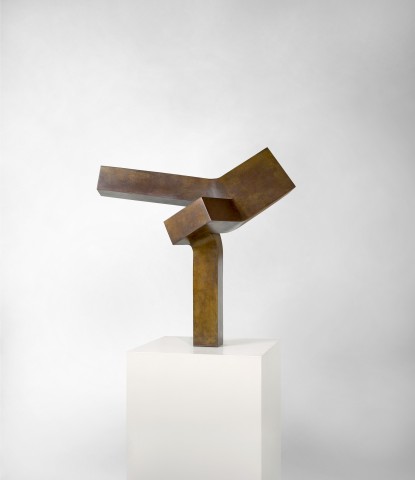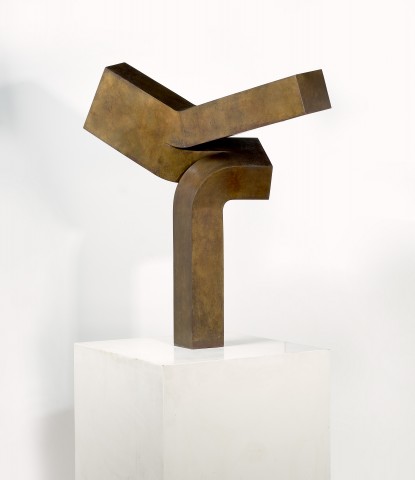OUTSPREAD, 1991
CLEMENT MEADMORE
bronze
93.0 x 92.0 x 62.0 cm
signed, dated and numbered at base: Meadmore 2000 3/6
dated, numbered, inscribed with title and monogram on base: "Outspread" / 2000 3/6 / ART
Robin Gibson Gallery, Sydney
Private collection, Tasmania, acquired from the above in October 2007
Clement Meadmore, Robin Gibson Gallery, Sydney, 17 November – 12 December 2007, cat. 13 (another example)
Outspread, 1991, painted aluminium, 1036.5 cm height, Adachi Ward, Tokyo, illus. in Gibson, E., The Sculpture of Clement Meadmore, Hudson Hills Press, New York, 1994, p. 122
Clement Meadmore is Australia’s most significant and internationally accomplished sculptor. In a career spanning over fifty years, most of which was spent in America, Meadmore’s work featured not only enormous breadth in scale from small-scale maquettes to monumental works – as evidenced by the larger, black-painted aluminium version of Outspread, 1991 (Adachi Ward, Tokyo) – but traversed a wide-ranging scope of complex forms within a minimalist framework. The purity of his formal conceptions and command of materials ensure that each sculpture is a consummate example showcasing an uncompromising eloquence and weightlessness – whether it is 30cm high or over 10 metres. Furthermore, each sculpture complies to the maxim of being viewed independently but successfully from every vantage, no matter the scale, in order that the form can exude its presence be it through its rhythm, physicality, or innate energy, to inhabit, shape and extend into the environment.
Meadmore’s early work initially depicted encrusted welded vertical rods, later moving to the raw uneven interconnected slabs of metal, before mastering and elaborating on the tenets of American minimalist sculptors, exemplified in the work of Tony Smith, Donald Judd and Richard Serra amongst others. In Meadmore’s mature work, Eric Gibson has observed roughly three main phases: the dense coiled sculptures of the 1960s; the sculptures composed of multiple parts made in the 1970s; and the branching sculptures of the 1980s.1 Each period reflects a meticulous and often unsettling fusion of uncompromising balance and tension – a relentless quest to make inert and unyielding materials (mostly bronze or aluminium) come alive. Whether taking the shape of tightly compacted coils, elegant musical note-like forms, or divergent angles or shapes, the sculpture must reflect the mastery of form through the now manipulated and exquisitely shaped material.
Outspread, 1991 belongs to Meadmore’s late period in which he looked back on his body of work as a resource to be retrospectively considered, evaluated and progressed. The divided angles expressed in Outspread, refer to a body of work completed in the 1980s such as Outcome, 1983; Offshoot, 1982; and Aside, 1983. In Outspread, Meadmore contemplates the exquisite tension of opposing sharply sliced angles which have been split and turned away from their original rectangular source. The energy of the protruding spliced angles penetrates the inhabited space, offering a sense of magnitude whilst resting on Meadmore’s iconic vertically curved rod-shaped base. Meadmore is in his element, converting an intractable material bronze into a free, spontaneous, and complex moving form.
1. Gibson, E., The Sculpture of Clement Meadmore, Hudson Hills Press, New York, 1994, p. 112
FIONA HAYWARD



